When it comes to design, we’ve come a very long way over the last 20 years. Today, we’re more preoccupied with user experience than we’ve ever been. As our understanding of UX expands, so does the complexity of our roles in the field. With each day, UX competencies become ever more granular.
Nowadays, you can come across a variety of titles like UX designer, UX architect, or UX analyst. While they pertain to the same field, they are by no means interchangeable.
In this article, we’d like to look into what each of these roles entails and what their responsibilities are.
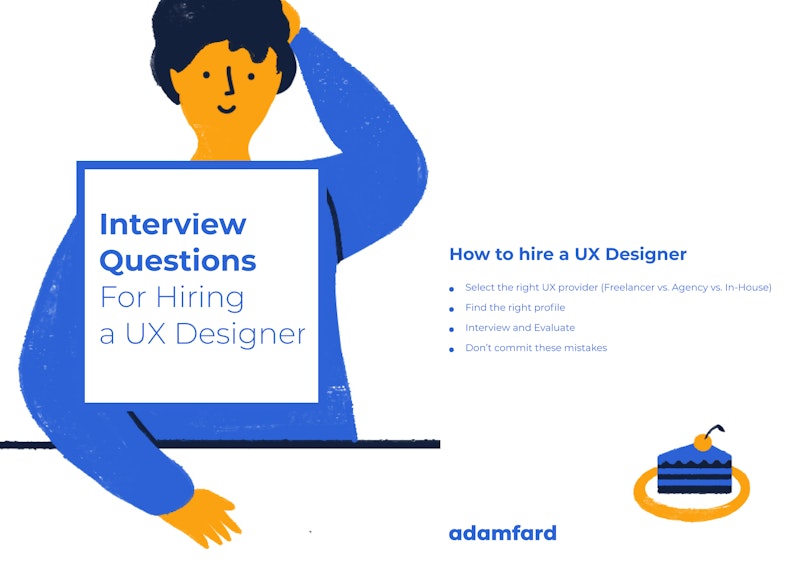
Download UX Designer Interview Questions!
Here are 20 interview questions helping you to find the right candidate:
Download NowWho is a UX architect?
User experience architects (aka information architects) focus on creating an intuitive flow for products. To do that, they’re often involved in interviewing and surveying users. Once they’ve collected all the essential information, they create prototypes and wireframes for the product. However, compared to designers, they have a more holistic view of the user’s path.
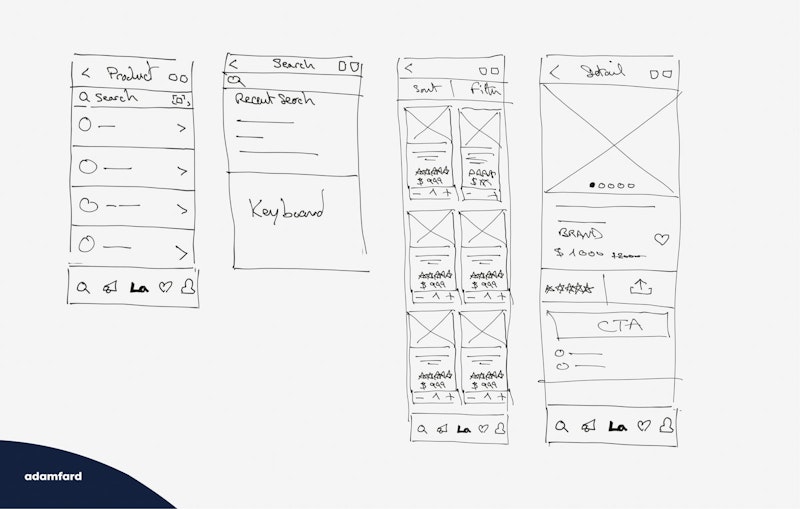
Examples of wireframes
How is an architect different from a designer?
It’s safe to say that the roles of a designer and an architect overlap to a certain extent. However, a UX designer’s responsibilities mostly have to do with the visual aspect of a user’s interaction with a product. An essential goal is to ensure that a product’s components address a person’s needs and expectations fully.
Questions that are commonly asked by UX designers are:
What are the product’s central objectives?
What are the end user’s needs, and how does the product address them?
What are the products’ content requirements?
What is the best approach regarding interaction design?
How should we approach navigation?
An information architect’s responsibilities have to do with the fundamental aspects of a product’s structure and its users’ needs. They aim to connect the end-user with the information they’re looking for.
They look for answers to more global questions like:
How can we ensure that information is provided in a user-friendly manner?
What’s the best approach to information classification and hierarchy?
What’s the best way to organize navigation and wayfinding?
Why you should hire a UX architect
UX architects are focused on facilitating access to information
They ensure a crystal-clear understanding of your users’ needs and how designers should address them
They solve important usability and accessibility problems
They have an extensive skill set and are efficient problem-solvers
The takeaway: UX architects are focused on the overall structure of a product. They have a more holistic approach to information compared to designers.

Who is a UX analyst?
An analyst’s role is also rooted in research. Their goal is to thoroughly study the users’ needs and whether their clients’ goals align with usability standards. By studying the product’s customers, UX analysts establish the features that will help users reach their goals.
Analysts are also preoccupied with users’ success rate when it comes to executing specific tasks in a product. They’re always looking for ways to improve the overall experience of a product and increase customer satisfaction.
Some of the more commonly asked questions in this field are:
Can all the users perform a specific task?
How much time does it take them to reach their goal? How can we make this pathway shorter without damaging experience?
How often do users commit errors? How can we decrease this number?
How satisfied are users with the product? Can we increase their satisfaction while keeping business goals in mind?
How can we transform usability observations into meaningful changes?
Why you should hire a UX analyst
UX analysts are focused on customer satisfaction
They extract actionable recommendations from studying users
They continuously improve your product’s usability
They are naturally curious about the ways people interact with devices and look for means to make it more efficient and successful
The takeaway: UX analysts care about customer satisfaction. They’re continually looking into ways to improve the product’s usability and reduce user errors.
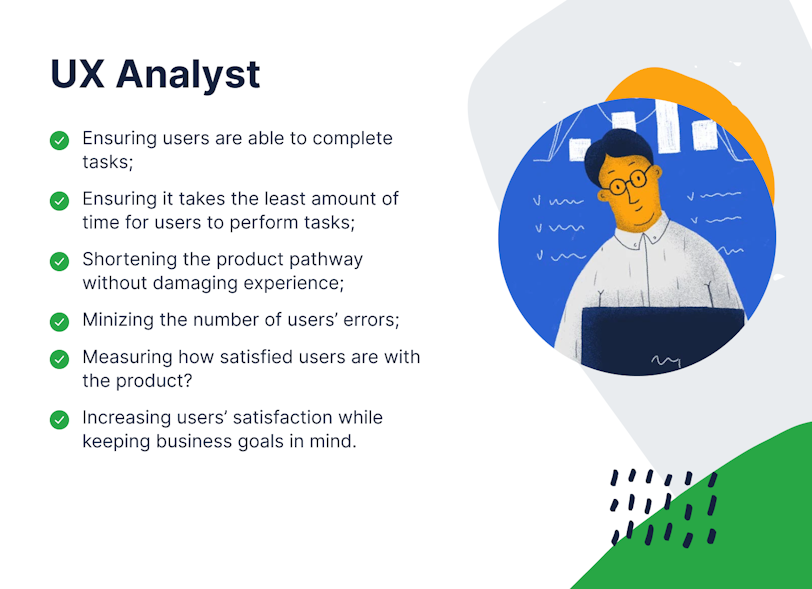
Who is a UX designer?
A UX designer’s spectrum of responsibilities is fairly broad. They care about making products usable, accessible, and enjoyable. In most business settings, they’ll be the only person advocating for users.
Compared to UX architects and analysts, designers are one the frontline of crafting a usable product. At the end of the day, they are the ones making decisions about how things are structured.
Why you should hire a UX designer
They care about the end-user’s needs and your product’s objectives
One of their central focuses is usability, along with making products useful and enjoyable
They care about your product’s efficiency
Their expertise in user experience helps your product convert significantly better
The takeaway: a UX designer is a fundamental role that encompasses a variety of fields. Of the three, they are most preoccupied with the visual aspect of things.
Further reading: How to hire a UX Designer [guide]
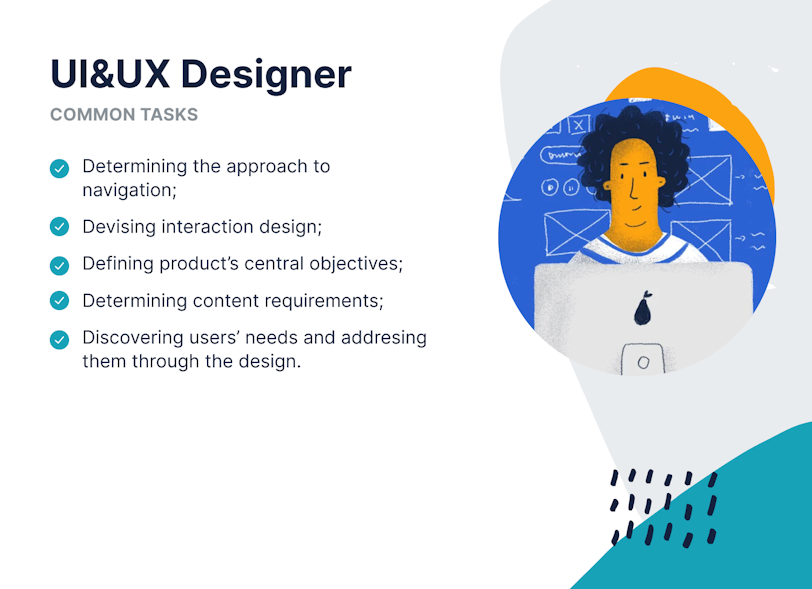
Are these classifications still relevant?
In many settings, a UX designer’s responsibilities overlap with the ones of an architect or analyst. It’s very complicated to draw a line in the sand and establish a “no-go zone” for either one.
This is especially relevant in startups when businesses can’t afford to have a full-on user experience team. UX designers will sometimes have to make decisions about architecture and customer journey, as well as visual design.
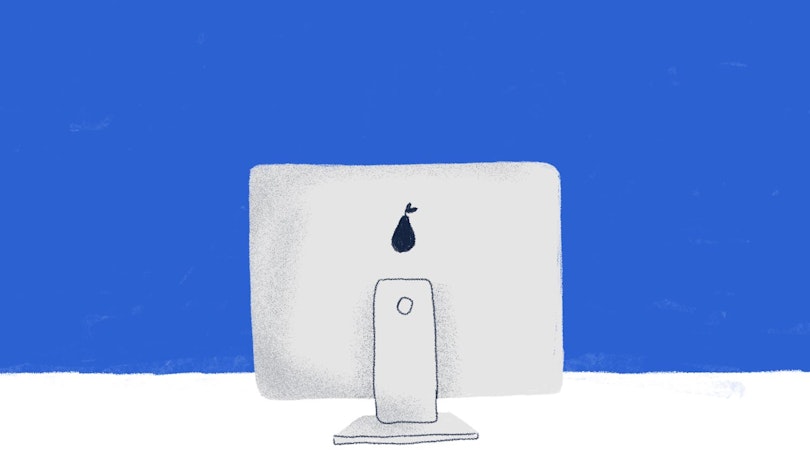
The breadth of a UX specialist’s duties is often defined by the product, the budget, and the company they work in. This means that you can be heavily involved in user research if your company doesn’t have an actual UX researcher. Sometimes, designers write UX copy, if the company can’t afford a UX writer.
It’s best to think of each role as a person that is oriented towards a specific aspect of UX but never limited to a set of particular things.
Working together
You'd think with such distinct titles, UX architects, analysts, and designers would have clearly defined territories while on a project.
But in the real world, the lines often blur. It's like a Venn diagram with overlapping circles of responsibilities.
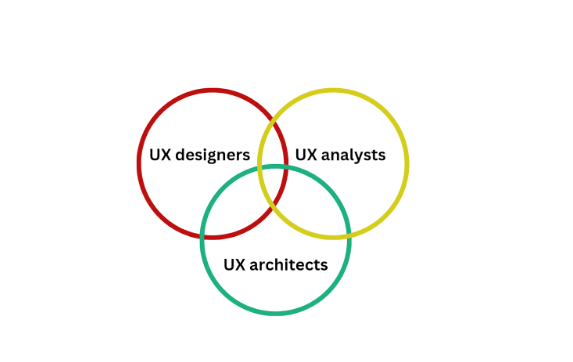
For instance, an architect might find themselves deeply involved in user research, which is more the analyst's domain. Or a designer might be asked to create information architecture blueprints, typically an architect's job. This overlap can have both advantages and disadvantages.
On the one hand, it promotes a well-rounded team where everyone has a broader understanding of the process. On the other, it can lead to confusion about roles and responsibilities, especially in smaller teams or during tight deadlines.
Communication is important
To navigate this overlap successfully, clear communication and a shared understanding of each role's core competencies are essential. Teams should establish guidelines for when and how to collaborate on tasks that fall into the grey areas.
Regular check-ins and open discussions can also help prevent misunderstandings and ensure everyone is on the same page.
Other emerging UX roles to consider
The UX landscape is constantly evolving, giving rise to new and specialized roles. Let's explore some of these emerging positions.
UX Researcher
First up is the UX researcher. While research has always been a cornerstone of UX, this role is becoming increasingly specialized. UX researchers delve deep into understanding user behavior, motivations, and pain points. They employ a variety of research methods, from surveys and interviews to usability testing and A/B experiments. Their insights are invaluable in informing design decisions and ensuring products truly meet user needs.
UX Writer
Next, we have the UX writer. As digital products become more complex, the importance of clear and concise language grows. UX writers craft the words users interact with, from button labels to in-app messages. They work closely with designers and developers to ensure that the written content enhances the overall user experience.
UX Strategist
Finally, the UX strategist is gaining prominence. This role involves developing the overarching UX vision for a product or company. UX strategists conduct market research, identify target audiences, and define user needs. They then create a roadmap for delivering exceptional user experiences, aligning business goals with user satisfaction.
These are just a few examples of emerging UX roles. As technology continues to advance and user expectations evolve, we can expect to see even more specialized positions emerge in the future.
Career guidance: level up your UX game
So, you want to level up your UX career? Let’s break down some ways to do just that regardless of the specialization you choose.
Building a Strong Foundation: First things first, you need a solid base. This means getting a good grasp of design principles, understanding how people tick (psychology is your friend here), and getting tech-savvy. And let’s not forget your portfolio. It's your calling card, so make it shine! Keep learning, too. This field moves fast, so stay curious and keep your skills sharp.
Climbing the Ladder: Once you’ve got the basics down, it’s time to level up. Think about specializing in a particular area of UX. Maybe you’re a research whiz, or perhaps you’re a design guru. Focusing on your strengths can really boost your career.
Networking is also key. Connect with other UX folks, attend industry events, and join online communities. A strong network can open doors to new opportunities. And don’t be afraid to seek out a mentor. Having someone experienced in your corner can provide invaluable guidance.
Ready to explore UX salaries and trends?
Industry insights: let's talk money and the future
Alright, let's get real. Everyone loves getting paid well while doing their jobs, right? So let's break down the world of UX salaries and what the future holds.
The Money Talk: Let's be honest, salary is a big deal. But it varies based on experience, location, company size, and even your specialization within UX. Generally, UX roles can be pretty lucrative, especially in tech hubs. But remember, it's not just about the paycheck.
Consider factors like company culture, growth opportunities, and the chance to work on exciting projects.
According to Glassdoor:
UX analysts earn between $75-135k
UX designers earn between $79-142k
UX architects earn between $104 - 186k
The future of UX roles
The future is bright: The demand for skilled UX professionals is booming. As more and more companies realize the importance of user experience, job opportunities are expanding. We also have to consider emerging tech like AI, VR, and AR completely changing the game. Imagine designing experiences in virtual worlds! But with great power comes great responsibility. Ethical design is becoming increasingly important. It's about creating tech that benefits everyone, not just a select few.
So, we’ve offered a glimpse into the world of UX salaries and what the future holds. Now, you might be looking for some practical tips and resources; we’ve got you covered.
Practical resources: your UX toolkit
In this section, we discuss some popular tools used by UX analysts, architects, and designers.
UX analyst tools
UX analysts focus on gathering and analyzing data to understand user needs and behaviors. Common tools include:
User research tools:
Survey tools: SurveyMonkey, Google Forms, Typeform
User testing platforms: UserTesting, Maze, TryMyUI
Interview and observation tools: Zoom, Google Meet, Miro
Analytics tools: Google Analytics, Adobe Analytics
Data analysis tools:
Statistical software: SPSS, R, Python (with libraries like Pandas, NumPy)
Data visualization tools: Tableau, Power BI, Looker
Qualitative analysis software: NVivo, Atlas.ti
UX architect tools
UX architects focus on creating the structure and flow of a product. Their tools often involve diagramming and information architecture:
Diagramming and wireframing tools:
Wireframing tools: UX Pilot, Sketch, Adobe XD
Diagramming tools: Miro, Lucidchart, Draw.io
Prototyping tools: InVision, ProtoPie, Framer.
Information architecture tools:
Card sorting tools: Optimal Workshop, UserZoom
Site mapping tools: MindMeister, Coggle
UX designer tools
UX designers focus on creating the visual interface and user experience. They utilize a combination of tools for design, prototyping, and collaboration:
Design tools:
Vector graphics: Adobe Illustrator, Sketch
UI design: Figma, Adobe XD, UX Pilot
Prototyping: InVision, ProtoPie, Framer, UX Pilot.
Collaboration tools:
Design systems: Figma, Zeplin, Adobe XD
Version control: Git, SVN
Project management: Jira, Trello, Asana
There is often overlap in the tools used by these roles. For example, UX designers might use survey tools for usability testing, and UX architects might use prototyping tools to visualize information architecture.
Stay Curious: The world of UX will keep evolving. Subscribe to design blogs like our up-to-date UX blog, attend webinars, and join online communities. There's always something new to learn.
So, there you have it—a quick rundown of practical resources to supercharge your UX career. Let's wrap things up with an actual case study demonstrating the UX roles in action.
Adam Fard UX Agency: A case study on the Keyveve project
Adam Fard UX Agency brought its full suite of expertise to the Keyveve project. By leveraging the unique strengths of our UX analysts, architects, and designers, we successfully transformed a nascent idea into a robust, user-centric debt management application.
The UX analyst's role
Our UX analysts at Adam Fard played a crucial role in understanding the core problem: how to simplify debt management for users. Through rigorous user research, including surveys, interviews, and focus groups, we identified key pain points such as difficulty in tracking multiple debts, lack of financial literacy, and emotional stress associated with debt.
These insights became the foundation for the entire project.
User personas created during the design of Keyveve. See the full case study.
The UX architect's contribution
Our UX architects were instrumental in structuring the Keyveve app for optimal user experience. We created a clear information architecture that organized debt information into easily digestible categories. By mapping out user flows, we ensured the journey from onboarding to goal achievement was smooth.
The information architecture.
The focus on usability and efficiency was crucial in making the app enjoyable to use.
The UX designer's impact
We brought the Keyveve app to life through visually appealing and intuitive interfaces. Our designers created wireframes and prototypes based on the insights gathered by analysts and the structure defined by architects. With a focus on user-centered design principles, we developed a visually pleasing and engaging app that motivated users to take control of their finances. We also created a consistent and on-brand experience throughout the app.
Finished designs for the Keyveve app.
Through the collaborative efforts of the full team, Adam Fard UX Agency successfully transformed the Keyveve concept into a user-centric solution that empowered individuals to effectively manage their debt.
The bottom line
It’s essential to underline that these roles are by no means interchangeable, despite the overlap. If you’re a company looking to hire a user experience specialist, carefully analyze the array of issues that need to be addressed.
Need help with preparing interview questions? Get our free template.
FAQ
How do you become a UX architect?
Typically, a UX architect is someone with extensive experience in product design who leans toward research.
What is the role of a UX architect?
A UX Architect ensures that a digital product is built on a solid structural foundation, while also satisfying the users' needs.





